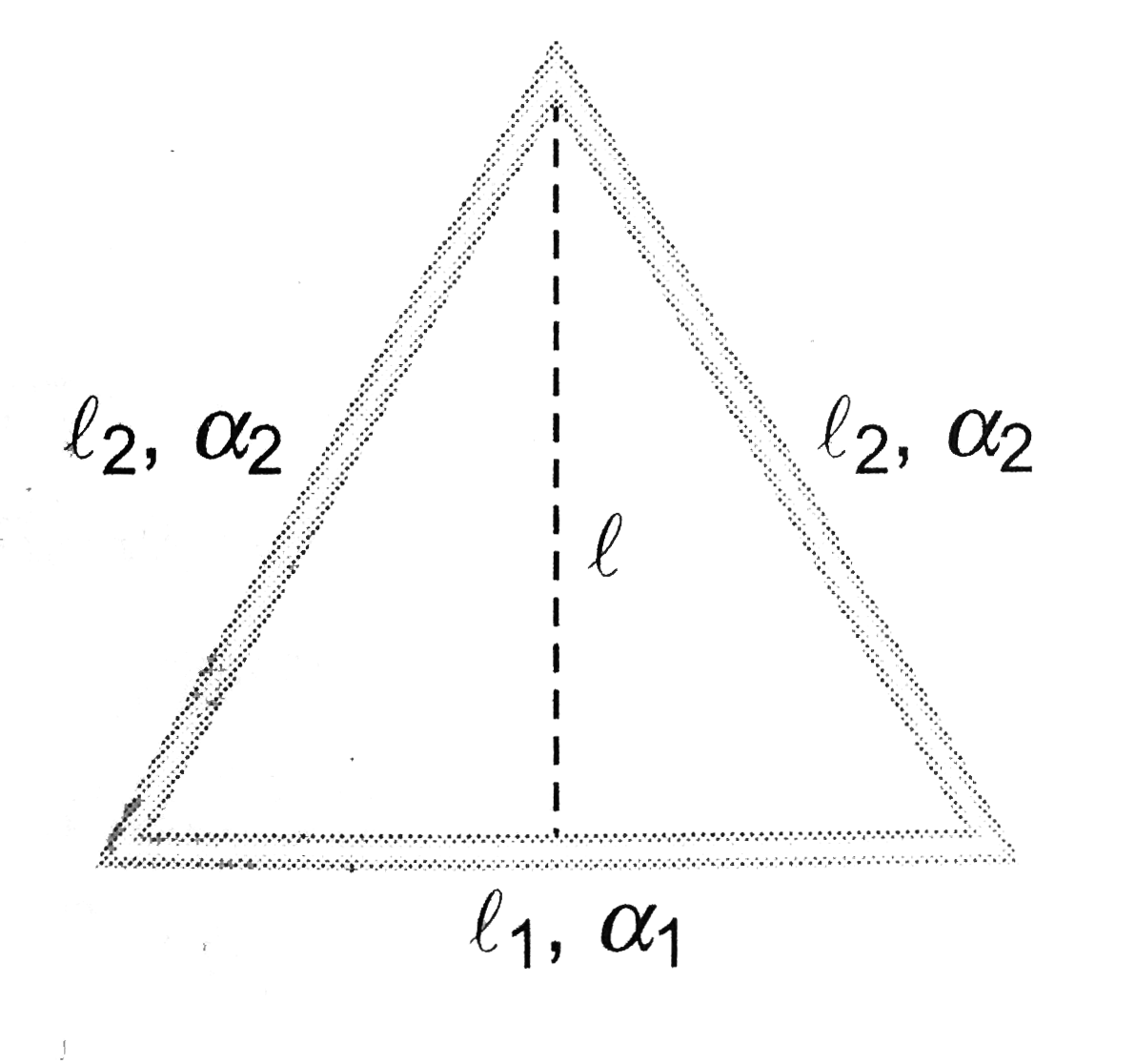If two rods of length L and 2L having coefficients of linear expansion α and 2α respectively are connected so that total length becomes 3L, the average coefficient of linear expansion of the composite rod equals
A) 32α
B) 52α
C) 53α
D) None of these
The correct Answer is:C
To find the average coefficient of linear expansion of the composite rod formed by two rods of lengths L and 2L with coefficients of linear expansion α and 2α respectively, we can follow these steps:
Step 1: Understand the lengths and coefficients
We have two rods:
- Rod 1: Length = L, Coefficient of linear expansion = α
- Rod 2: Length = 2L, Coefficient of linear expansion = 2α
Step 2: Calculate the total initial length
The total initial length Ltotal of the composite rod is the sum of the lengths of the two rods:
Ltotal=L+2L=3L
Step 3: Calculate the change in length for each rod
The change in length ΔL for each rod due to a temperature change ΔT can be calculated using the formula:
ΔL=L⋅α⋅ΔT
For Rod 1:
ΔL1=L⋅α⋅ΔT
For Rod 2:
ΔL2=2L⋅(2α)⋅ΔT=4L⋅α⋅ΔT
Step 4: Calculate the total change in length of the composite rod
The total change in length ΔLtotal of the composite rod is the sum of the changes in length of both rods:
ΔLtotal=ΔL1+ΔL2=(L⋅α⋅ΔT)+(4L⋅α⋅ΔT)=5L⋅α⋅ΔT
Step 5: Calculate the average coefficient of linear expansion
The average coefficient of linear expansion ¯α of the composite rod can be defined as:
¯α=ΔLtotalLtotal⋅ΔT
Substituting the values we found:
¯α=5L⋅α⋅ΔT3L⋅ΔT
Step 6: Simplify the expression
Cancel L and ΔT from the numerator and denominator:
¯α=5α3
Final Answer
Thus, the average coefficient of linear expansion of the composite rod is:
¯α=5α3
We have two rods:
- Rod 1: Length = L, Coefficient of linear expansion = α
- Rod 2: Length = 2L, Coefficient of linear expansion = 2α
The total initial length Ltotal of the composite rod is the sum of the lengths of the two rods:
Ltotal=L+2L=3L
The change in length ΔL for each rod due to a temperature change ΔT can be calculated using the formula:
ΔL=L⋅α⋅ΔT
ΔL1=L⋅α⋅ΔT
ΔL2=2L⋅(2α)⋅ΔT=4L⋅α⋅ΔT
The total change in length ΔLtotal of the composite rod is the sum of the changes in length of both rods:
ΔLtotal=ΔL1+ΔL2=(L⋅α⋅ΔT)+(4L⋅α⋅ΔT)=5L⋅α⋅ΔT
The average coefficient of linear expansion ¯α of the composite rod can be defined as:
¯α=ΔLtotalLtotal⋅ΔT
¯α=5L⋅α⋅ΔT3L⋅ΔT
Cancel L and ΔT from the numerator and denominator:
¯α=5α3
Thus, the average coefficient of linear expansion of the composite rod is:
¯α=5α3
Topper's Solved these Questions
Similar Questions
Two metallic rods of length l and 3l have coefficient of linear expansion α and 3α respectively. The coefficient of linear expansion ofr their series combinations, is
View SolutionThere are two rods of length l1 and l2 and coefficient of linear expansions are α1 and α2 respectively.
Find equivalent coefficient of thermal expansion for their combination in series.
View Solution
Knowledge Check
If α,β and γ coefficient of linear, superficial and volume expansion respectively, tehn
Aβα=12Bβγ=23Cγα=32Dβα=γβ
Two rods of lengths l1andl2 are made of materials having coefficients of linear expansion α1andα2 respectively. What could be the relation between above values, if the difference in the lengths of the two rods does not depends on temperature variation?
View SolutionTwo rods having length l1 and l2, made of materials with the linear coefficient of expansion α1 and α2 were welded together. The equivalent coefficients of linear expansion for the obtained rod:-

View SolutionTwo different wires having lengths L1 and L2 and respective temperature coefficient of linear expansion α1 and α2 are joined end - to - end . Then the effective temperature coefficient of linear expansion is :
View SolutionAn isosceles triangles is formed with a thin rod of length l1 and coefficient of linear expansion α1, as the base and two thin rods each of length l2 and coefficient of linear expansion α2 as the two sides. The distance between the apex and the midpoint of the base remain unchanged as the temperature is varied. the ratio of lengths l1l2 is

View SolutionAn isosceles triangles is formed with a thin rod of length l1 and coefficient of linear expansion α1, as the base and two thin rods each of length l2 and coefficient of linear expansion α2 as the two sides. The distance between the apex and the midpoint of the base remain unchanged as the temperature is varied. the ratio of lengths l1l2 is

View SolutionAn isosceles triangles is formed with a thin rod of length l1 and coefficient of linear expansion α1, as the base and two thin rods each of length l2 and coefficient of linear expansion α2 as the two sides. The distance between the apex and the midpoint of the base remain unchanged as the temperature is varied. the ratio of lengths l1l2 is

View SolutionTwo rods each of length L2 and coefficient of linear expansion α2 each are connected freely to a third rod of length L1 and coefficient of expansion α1 to form an isoscles triangle. The arrangement is supported on a knife-edge at the midpoint of L1 which is horizontal. what relation must exist between L1 and L2 so that the apex of the isoscles triangle is to remain at a constant height from the knife edge as the temperature changes ?
View Solution